Trophy Belgian, British and French anti-tank guns in the German Armed Forces in World War II
Trophy anti-tank artillery in the German Armed Forces. After the surrender of Belgium, the Netherlands and France in June 1940, the German army had at its disposal numerous trophies, among which were thousands of guns suitable for fighting tanks. The British expeditionary forces during the evacuation from the Dunkirk area abandoned almost all the heavy equipment and weapons that were also subsequently used by the Germans.
Belgian 47-mm anti-tank gun C.47 FRC Mod.31
In the course of heavy fighting in Belgium, which lasted from 10 to 28 on May 1940, the Canon X-NUMX mm anti-char de 47mm Fonderie Royale de Canons Modèle 47 (abbreviated C.1931 FRC Mod.47) was actively used. The gun, developed in 31 by specialists from the Belgian company Fonderie Royale des Canons (FRC), was manufactured at an enterprise located in the suburbs of Liège. Deliveries of 1931-mm guns to the anti-tank units of the Belgian army began in the 47 year. In each infantry regiment, the anti-tank company had 1935 12-mm FRC Mod.47 guns. By the beginning of the German invasion of 31, more than 1940 copies were produced.
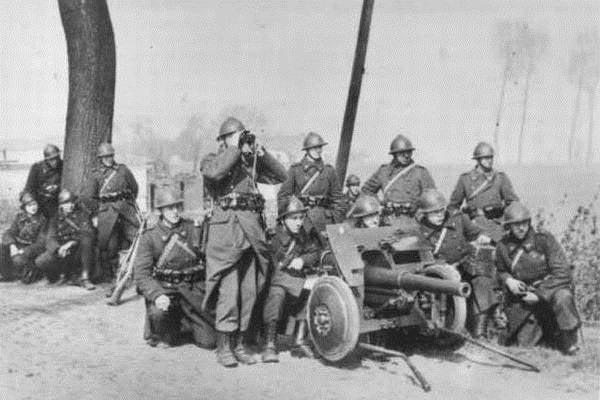
The gun had a monoblock barrel with a semi-automatic shutter mounted on a massive riveted gun carriage with sliding beds. Protection of the calculation from bullets and fragments was provided by a bent 4-mm steel shield. There were two main modifications to the guns - infantry and cavalry. They differed in minor details: the cavalry version was a bit lighter and had pneumatic tires. The infantry version had heavier, but also more durable wheels with all-rubber tires. Horse drawn teams, Marmon-Herrington Mle 1938, GMC Mle 1937 and lightweight tracked tractors Vickers Utility tractor were used for towing. Also, in the amount of about 100 pieces, guns were designed for installation inside long-term firing points. They differed from the infantry and cavalry versions by the absence of a wheel drive and a thicker shield.
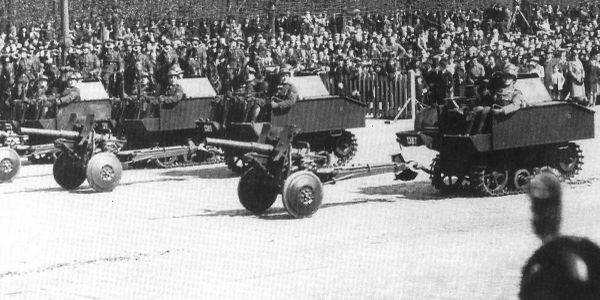
The C.47 FRC Mod.31 anti-tank gun was compact enough to be easily masked. A calculation of five people could roll it when changing positions. The mass of the gun in combat position was 515 kg. Vertical firing angles: from −3 ° to + 20 °. Horizontal - 40 °. Rate of Fire: 12-15 rds / min. An armor-piercing projectile weighing 1,52 kg left the barrel length 1579 with a speed of 720 m / s. At a distance of 300 m, when hit at a right angle, the projectile could penetrate 53 mm armor. Thus, the 47-mm Belgian gun was capable of hitting all serial German tanks in the 1940 year.
47-mm anti-tank guns were used to arm light artillery self-propelled guns. The base for the first Belgian tank destroyer was the British wedge heel Carden-Loyd Mark VI.
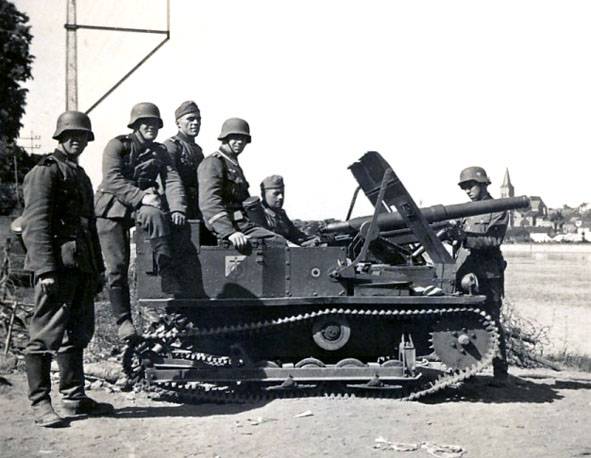
A more perfect example was the self-propelled installation on the chassis of the Vickers-Carden-Loyd Light Dragon Mk.IIB tracked tractor. Buiesingen's Miesse installed a C.NUMX-mm C.47 FRC Mod.47 anti-tank gun on this chassis in a rotating half-tower. The tank destroyer was designated T.31-B I.
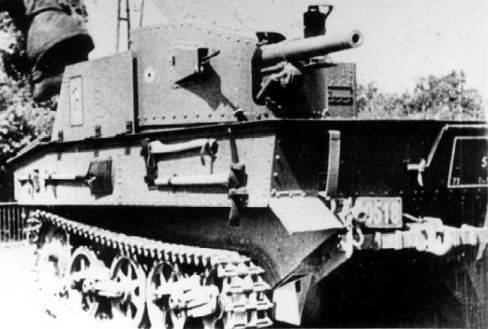
The anti-tank gun and the calculation of two people were located in a half-tower, covered with bulletproof armor. In this case, the gun looked back along the car. The horizontal firing sector was 120 °.
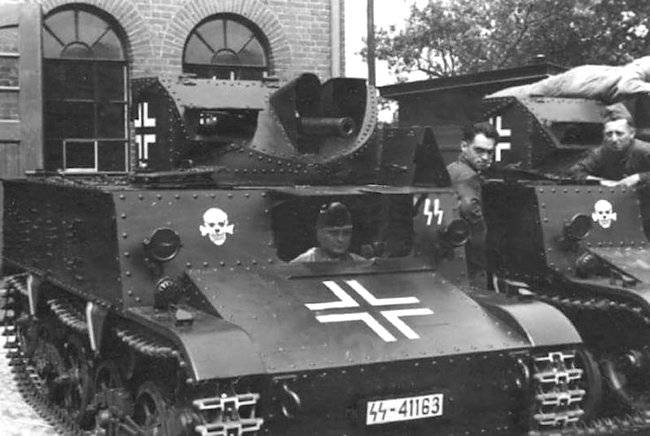
Modifications T.13-B II and T.13-B III had the usual "tank" layout, but the tower remained open behind. In total, the Belgian army received 200 self-propelled modifications: T.13-B I, T.13-B II and T.13-B III. In the German armed forces, Belgian self-propelled guns were used under the designations: Panzerjager and Panzerjager VA.802 (b).
The exact number of C.47 FRC Mod.31 guns captured by the Germans is not known; according to various estimates, they could be from 300 to 450 units. After the occupation of Belgium, the 47-mm anti-tank guns were adopted in Germany under the designation 4.7 cm Pak 185 (b). However, soon most of the guns were transferred to Hungary, where they received the designation 36M. The Germans placed the 47-mm guns in the fortifications of the “Atlantic Wall”.
British 40-mm anti-tank gun Ordnance QF 2-pounde
After the hasty evacuation of British troops from France, about 500 40-mm Ordnance QF 2-pounde anti-tank guns remained on the beaches around Dunkirk. A small number of "two-pound" was also captured in North Africa. According to the British classification, the cannon belonged to a fast-firing gun (hence the QF letters in the name - Quick Firing). The "Two Pound" conceptually differed from guns of a similar purpose created in other countries. Anti-tank guns usually had a small weight, since they had to accompany the advancing infantry and be able to quickly change positions with the forces of the calculation, and the 40-mm British gun was intended for firing from a fixed defensive position. When moving to a combat position, the wheel drive was separated, and the gun rested on a low base in the form of a tripod. Due to this, circular firing was provided, and the cannon could fire at moving armored vehicles in any direction. Strong adhesion to the ground of the cruciform base increased the accuracy of shooting, since the “two-pound” did not “walk” after each shot, maintaining its aim. Given the fact that there was a special seat for the gunner, this design was more characteristic of anti-aircraft guns.
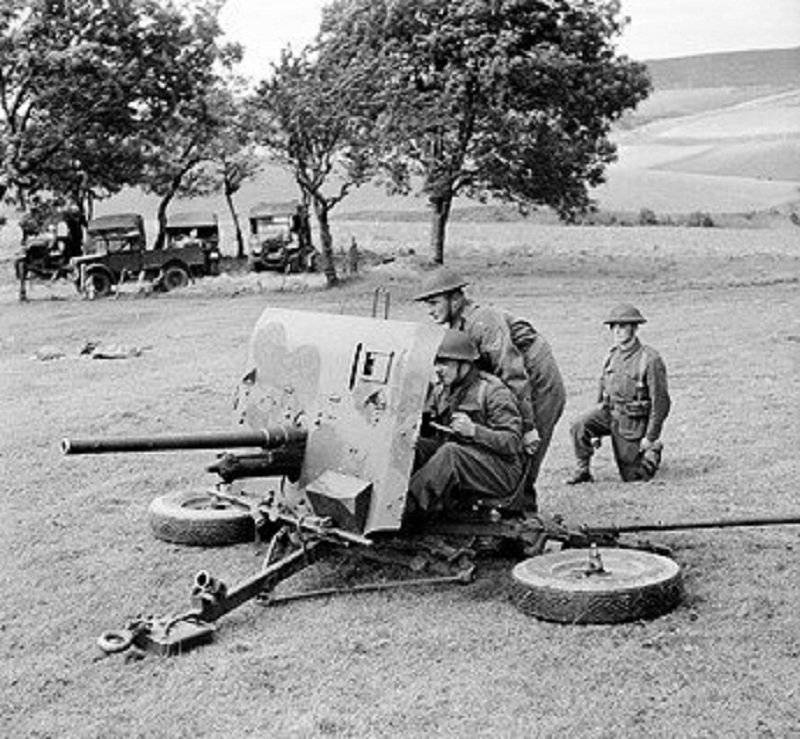
The calculation was protected by a high armor shield, on the back wall of which a box with shells was attached. In this case, the gun was quite heavy, its mass in combat position was 814 kg. Rate of fire - up to 20 rds / min.
The 40-mm Ordnance QF 2-pounde anti-tank gun from the 1937 year was produced by order of the Belgian army, and in the 1938 year it was adopted in the UK. It took some time to finalize the first samples to fully comply with army standards. In 1939, the version of the Mk IX carriage was finally approved for the gun. Initially, the "two-pound" did not greatly exceed the German 37-mm Pak 35 / 36 anti-tank gun in armor penetration. 40 mm. An armor-piercing blunt-headed projectile weighing 1,22 kg, having accelerated in the barrel with a length of 2080 mm to 790 m / s, pierced 457 mm armor at a normal distance of 43 meters. To increase efficiency, an armor-piercing shell of 1,08 mass with an enhanced powder charge was introduced into the ammunition, which at an initial speed of 850 m / s at the same range provided armor penetration of 50 mm. Given the fact that tanks with anti-shell armor appeared in Germany, special Littlejohn adapters worn on the barrel were developed for 40-mm anti-tank guns. This made it possible to shoot high-speed subcaliber shells with a special "skirt". The Mk I armor-piercing projectile projectile weighed 0,45 kg and, having left the barrel at a speed of 1280 m / s, could penetrate 91 mm armor at a range of 60 m at a viewing angle of 80 °. Also, the armor supplied Mk II shells of 0,57 mass with an initial speed of 1143 m / s. With the help of such ammunition, it was possible to overcome the frontal armor of the medium German tank Pz.KpfW.IV Ausf.H or the board of the heavy Pz.Kpfw.VI Ausf.H1, but only at a suicidal close range. Interestingly, in the Ordnance QF 2-pounde ammunition there were no fragmentation shells before the 1942, which limited the ability to fire on manpower, light field fortifications and unarmored equipment. The Mk II T fragmentation tracer, weighing 1,34 kg, containing 71 g of TNT, was introduced in the second half of the war, when the 40-mm guns had already lost their relevance.
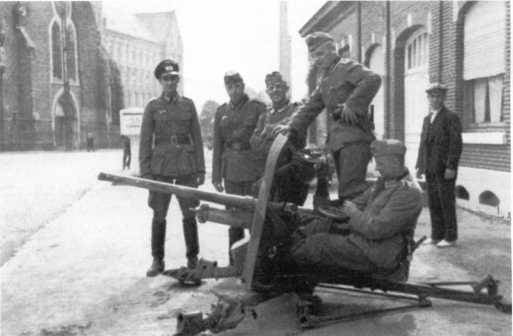
In the German armed forces, captured English guns received the designation Pak 192 (e), and captured in Belgium - 4,0 cm Pak 154 (b). 40-mm anti-tank guns were limitedly used by the German African corps. Due to low mobility, most of the guns were placed in the fortifications of the Atlantic Wall. But, the Germans could use a certain number of 40-mm guns at the final stage of the war against Soviet tanks. However, after the 1942 of the year, “two-pounds” did not meet modern requirements, and the lack of ammunition and spare parts greatly limited their use.
French anti-tank guns caliber 25-47-mm
At the beginning of the 1930 of the last century, all tanks under construction in series had bulletproof armor. In addition, based on the experience of the First World War, French generals did not appreciate the ability of tanks to overcome deeply echeloned defenses, reinforced with special anti-tank barriers. To deal with relatively low-speed vehicles covered with armor no more than 25 mm thick, a compact gun was required, with a low silhouette and low weight. Which could be easily masked and rolled by forces of calculation on the battlefield pitted with craters. At the same time, for mass production, the gun had to be as simple and inexpensive as possible.
In the 1933 year, Hotchkiss et Cie introduced the 25-mm anti-tank gun for testing. When designing this gun, we used the operating time of a cannon intended for arming light tanks, which were put “under the cloth” in connection with the end of the First World War. Having put the barrel of the failed tank gun on a two-wheeled carriage with sliding beds and a small shield, we quickly managed to get a very decent anti-tank artillery for its time. It was adopted by the designation Canon 25 mm SA Mle 1934 (25-mm semi-automatic gun of the 1934 model of the year). In 1934, Hotchkiss received an order to manufacture the first batch of 200 such tools.
The mass of the 25-mm gun in the combat position was 475 kg, and for such a caliber the Canon 25 mm SA Mle 1934 was quite heavy. The weight of the 25 mm French gun was almost the same as that of the 37 mm German PTO Pak 35 / 36. The angles of vertical guidance ranged from −5 ° to + 21 °, horizontal - 60 °. In the combat position, the gun was hung with the help of stands and additional emphasis. A well-trained calculation from 6 could make up to 20 aimed shots per minute.
For shooting, only armor-piercing tracer and armor-piercing shells were used. The weight of the armor-piercing tracer shell was 320 g, the armor-piercing projectile was 317 g. With a barrel length of 1800 mm, the initial velocity was 910-915 m / s. According to the advertising data of the Hotchkiss company, at a distance of 400 m at a meeting angle of 60 ° the projectile could penetrate armor with a thickness of 40 mm. In reality, the capabilities of the guns were much more modest. During tests in the USSR, real armor penetration at the same angle was: 36 mm at 100 m, 32 mm at 300 m, 29 mm at 500 m. Although the 25-mm projectile successfully overcame light armor tanks, its striking effect after penetration was relatively modest, which did not guarantee the failure of the tank.
The Canon 25 mm SA Mle 1934 anti-tank guns used lightweight Renault UE and Lorraine 37 / 38 tracked tractors. However, the 25-mm gun turned out to be too "tender", because of the risk of destruction of the towing devices and breakdown of the aiming mechanisms, the cross-country speed was not more than 15 km / h, and on the highway - 30 km / h. For the same reason, the transportation of guns transferred to the British expeditionary forces was carried out in the back of a car.
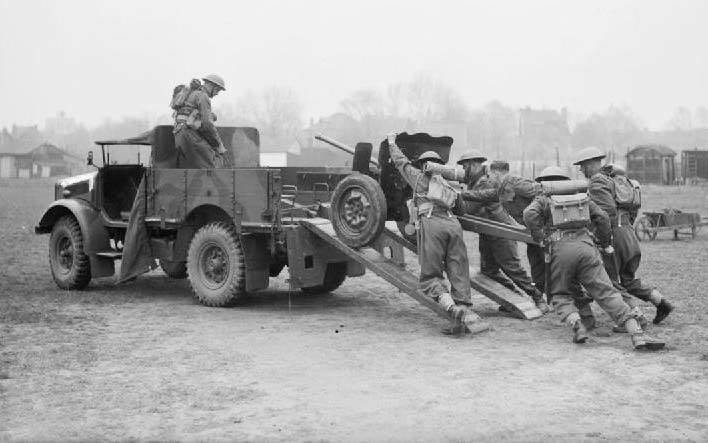
The variant, which was designated Canon 25 mm SA Mle 1934 modifie 1939, received a more durable carriage, which allowed to remove restrictions on towing speed. The army ordered 1200 of such cannons, but a few units were placed in the troops before the surrender of France.
In 1937, a new modification was adopted - Canon 25 mm SA-L Mle 1937 (the letter "L" meant leger - "light"). This gun, developed by the l'Atelier de Puteaux arsenal, weighed only 310 kg in combat position. Outwardly, it was distinguished by the altered shape of the shield and flame arrester. The shutter and the trigger were also refined, which increased the rate of fire.
According to archival data, until May 1 1940, army representatives accepted the Canon 4225 mm SA Mle 25 and 1934 Canon 1285 mm SA-L Mle 25 guns. By the beginning of World War II, each French infantry division had 1937 52-mm guns: 25 in each of the three infantry regiments (including 12 in each battalion and 2 in the regimental anti-tank company), 6 in the divisional anti-tank company, 12 - in the intelligence group.
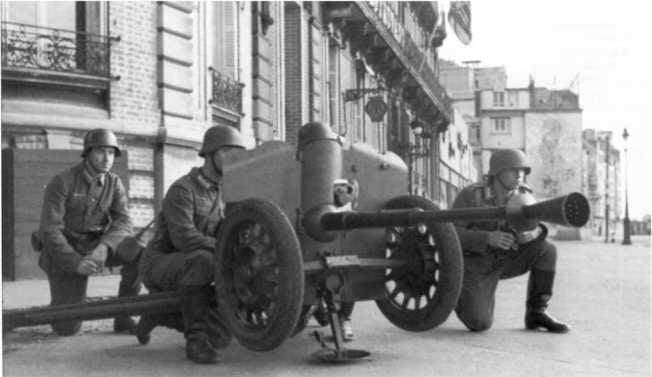
Approximately 2500 25-mm guns were captured by the German army in a condition suitable for further use. In the Wehrmacht, they received the designation Pak 112 (f) and Pak 113 (f). The cannons were mainly installed in the fortifications of the Atlantic Wall and Channel Islands. Some of them were transferred to Finland, Romania and Italy.
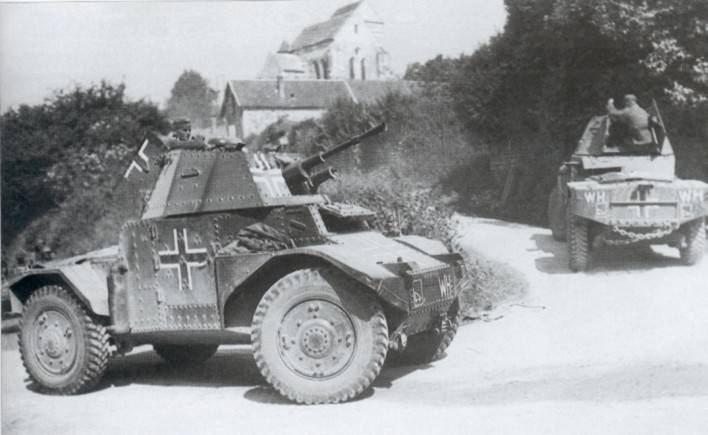
25-mm guns were armed with German armored personnel carriers Sd.Kfz.250 and captured French Panhard 178 armored vehicles, which had the German designation Pz.Spah.204 (f).
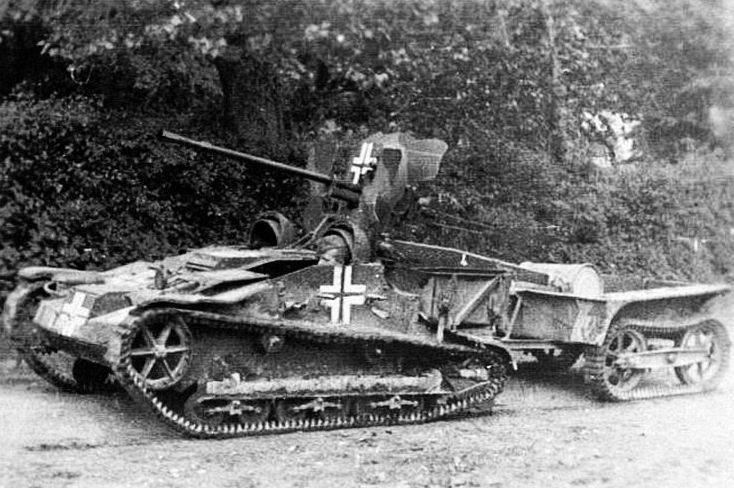
The captured 25-mm guns were also used to create self-propelled artillery mounts on the chassis of Renault UE and Universal Carrier lightly armored tracked tractors, a significant amount of which was captured in France and Belgium.
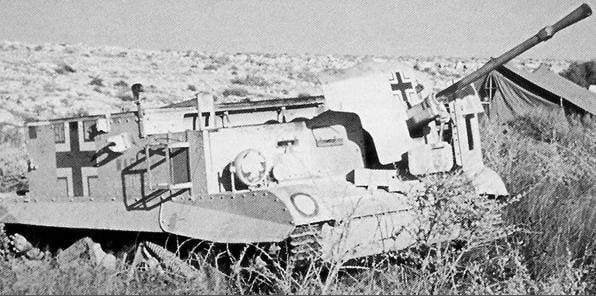
Armored vehicles and light self-propelled guns with 25-mm guns fought in North Africa during the initial period of hostilities in the USSR. They were successfully used against armored vehicles and light tanks, however, they themselves were very vulnerable to small-caliber armor-piercing shells and large-caliber armor-piercing bullets, and therefore suffered heavy losses. For this reason, after the 1942 year, the 25-mm guns were not used in parts of the first line.
The 47-mm Canon antichar de 47 mm modèle 1937 cannon, designed by l'Atelier de Puteaux, was a much greater danger to tanks with anti-shell armor. The gun had a monoblock barrel with a semi-automatic shutter mounted on a carriage with sliding beds, shatterproof shield and metal sprung wheels with rubber tires.
For an anti-tank gun of this caliber, the weight in combat position was very significant - 1050 kg. The transport of the guns and the front with charging boxes was carried out by a team of four horses. Mechanized traction was provided by the light Citroen-Kégresse P17 semi-tracked tractors and the Laffly W15 all-wheel drive trucks. Approximately 60 guns were used to equip the Laffly W15 TSS tank destroyers, which were Laffly W15 trucks with anti-shatter armor.
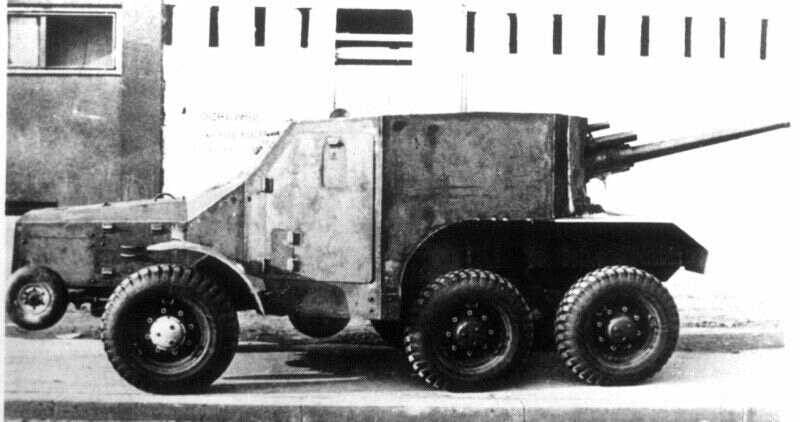
The anti-tank 47-mm gun was installed in the aft and could fire backwards along the machine. It is clear that such a self-propelled gun had a chance of success only with actions from an ambush, in previously prepared positions. Laffly W15 TCC self-propelled guns were organized into separate anti-tank batteries, each of which had 5 vehicles.
The ammunition of the 47-mm gun included unitary shots with an armor-piercing projectile Mle 1936 weighing 1,725 kg. With a barrel length of 2444 mm, the projectile was accelerated to 855 m / s, and at a distance of 500 m at a viewing angle of 60 ° it could penetrate 48 mm armor. At a range of 1000 m, armor penetration was 39 mm. Considering that the gun could launch 15-20 shells per minute, in the 1940 year it represented a danger to all German tanks participating in the French campaign. Although for the Canon antichar de 47 mm modèle 1937 there was an Mle 1932 fragmentation shell weighing 1,410 kg, in the 47-mm troops fragmentation shells were usually absent, which did not allow effective fire on enemy manpower.
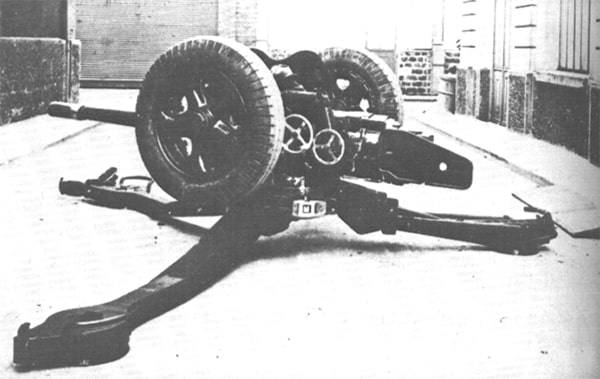
In the 1940 year, for the 47-mm anti-tank gun SA Mle 1937 developed a carriage that provides circular rotation. The design resembled the scheme of the post-war Soviet howitzer D-30 and was far ahead of its time. This carriage, although it provided some advantages, was overly complicated for a mass anti-tank gun, which became the main obstacle to the mass production of SA Mle 1937.
The 47 mm anti-tank guns of the Canon antichar de 47 mm modèle 1937 were used as part of the anti-tank companies attached to motorized and infantry regiments.
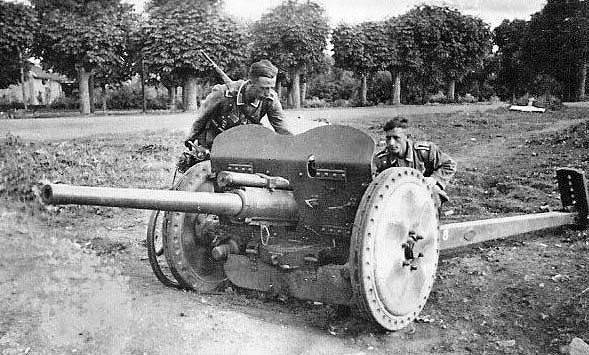
Until May 1 of 1940, 1268 guns were released, of which 823 pieces were captured by the German army, and was used under the designation 4,7 cm Pak 181 (f). The Germans installed some of the guns on the chassis of the captured French Lorraine 37 light tracked tractors.
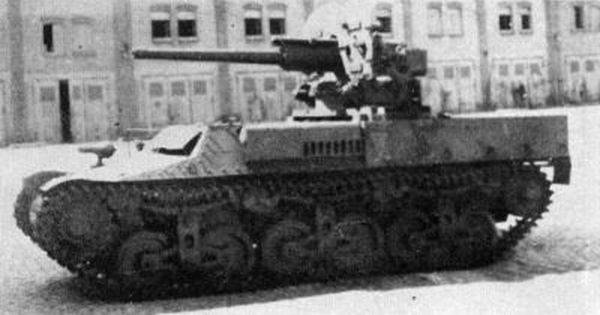
About three hundred 47-mm guns in the 1941 year entered service with the tank fighter divisions of a number of infantry divisions operating on the Soviet-German front. Considering that standard French-made armor-piercing shells could hit the T-34 tank in the forehead only at a distance of about 100 m, and no penetration of the front armor of heavy HFs was provided, at the end of the 1941 year, shots with German sub-caliber shells were introduced into the ammunition. At a distance of 100 m, a caliber projectile normally pierced 100 mm armor, at 500 m - 80 mm. The production of 47-mm high-speed shells with increased armor penetration was completed at the beginning of the 1942 year due to tungsten deficiency.
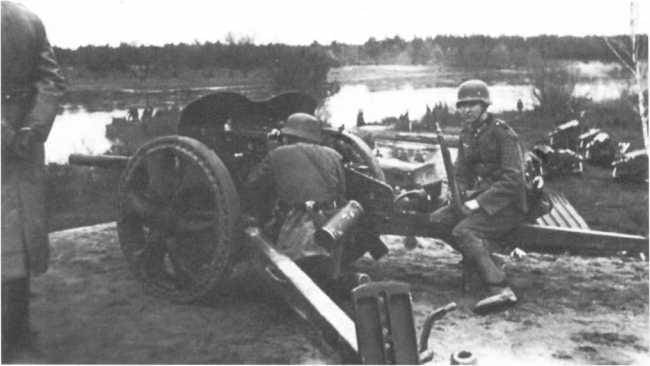
47-mm Pak 181 (f) anti-tank gun at firing position. Autumn 1941 of the year, the Soviet-German front
In the second half of 1942, most of the surviving Pak 181 (f) were withdrawn from the first line units. The 47-mm guns, which had lost their relevance, were left on secondary sectors of the front and sent to fortifications of the Atlantic Wall.
75-mm anti-tank gun 7,5 cm Pak 97 / 38, created using the swinging part of the French division gun Canon de 75 mle 1897
In France and Poland, the Wehrmacht captured several thousand 75-mm cannon divan guns Canon de 75 mle 1897 and over 7,5 million shots to them. The French gun Canon de 75 Modèle 1897 (Mle. 1897) was born in the 1897 year and became the first in stories commercially available quick-firing gun equipped with recoil devices. During the First World War, it formed the basis of the French field artillery, retaining its position in the interwar period. In addition to the basic version, a number of Mle. Guns, featuring modernized carriages and metal wheels with pneumatic tires, became German trophies.
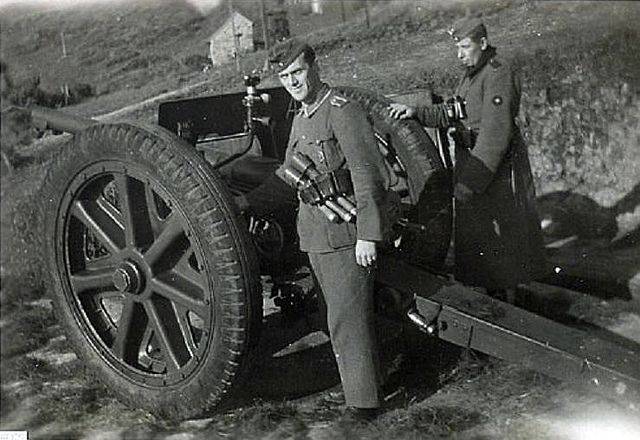
Initially, the Germans used them in their original form, giving the Polish gun the name 7,5 cm FK97 (p), and the French - 7,5 cm FK231 (f). These guns were sent to the "second line" division, as well as to the coastal defense of Norway and France. It was difficult to use these obsolete guns to fight tanks even with an armor-piercing projectile in the ammunition because of the small pointing angle (6 °) allowed by a single-beam carriage. The absence of springs allowed towing at a speed of not more than 12 km / h even on a good highway. In addition, the German military did not like the gun, adapted only for horse traction.
However, German designers found a way out: the swinging part of the 75-mm French gun Mle. 1897 was superimposed on the carriage of the German 50-mm anti-tank gun 5,0 cm Pak 38 with extendable tubular beds and a wheel drive, which provides the possibility of towing mechanized traction. To reduce recoil, the barrel was equipped with a muzzle brake. The Franco-German “hybrid” was adopted under the designation 7,5 cm Pak 97 / 38.
The mass of the gun in combat position was 1190 kg, which was quite acceptable for such a caliber. The angles of vertical guidance from −8 ° to + 25 °, in the horizontal plane - 60 °. 7,5 cm Pak 97 / 38 retained its piston shutter, which provided a very satisfactory rate of fire 10-12 rds / min. The ammunition included unitary shots of German, French and Polish production. German ammunition is represented by three types of cumulative shots, the French with a regular Mle1897 high-explosive fragmentation shell, armor-piercing shells were of Polish and French production.
An armor-piercing projectile weighing 6,8 kg left the barrel with a length of 2721 mm with an initial speed of 570 m / s, and at a distance of 100 m at a viewing angle of 60 ° it could penetrate 61 mm armor. Due to insufficient armor penetration, the 7,5 cm Pak 97 / 38 ammunition was loaded with 7,5 cm Gr.38 / 97 Hl / A (f), 7,5 cm Gr.38 / 97 Hl / B (f) and cumulatively tracer XN .7,5 / 97 Hl / C (f). Their initial speed was 38-450 m / s, the effective firing range was up to 470 m. According to German data, cumulative projectiles normally pierced up to 1800 mm of armor, at an angle of 90 ° - up to 60 mm. Penetration of cumulative shells, allowed to fight with medium tanks, and when firing on board with heavy. More often than for firing at armored targets, the 75-mm "hybrid" gun was used against manpower and light field fortifications. In 75 – 1942, about 1944 million rounds were launched with high-explosive fragmentation grenades, and about 2,8 million rounds with cumulative shells.
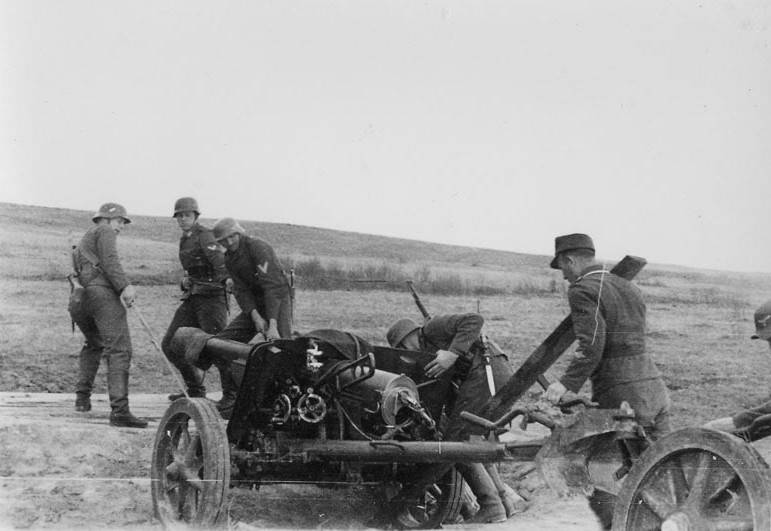
The relatively small mass of the 75-mm gun 7,5 cm Pak 97 / 38 and the presence of an additional wheel under the bed made it possible to roll it with calculation forces.
The positive qualities of the French-German cannon include the possibility of using a significant number of captured high-explosive fragmentation rounds, which were both used in their original form and converted into cumulative ones. The relatively small mass of the 7,5 cm Pak 97 / 38, comparable to the 5,0 cm Pak 38, provided good tactical mobility, and the low silhouette made it difficult to detect. At the same time, the low initial velocity of the 7,5cm Pak 97 / 38 shells made it possible to use for the battle with tanks, primarily cumulative shells, which at that time were not sufficiently structurally and technologically developed. They had insufficient direct range, increased dispersion during firing and not always reliable operation of the fuses.
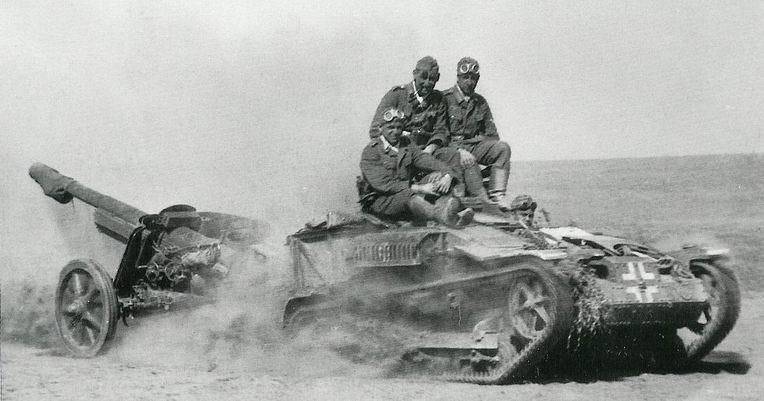
For transportation of 7,5 cm Pak 97 / 38 we used horse carts, wheeled trucks, as well as trophy light tracked tractors Vickers Utility Tractor B, Renault UE and Komsomolets.
The release of 7,5 cm Pak 97 / 38 lasted from February 1942 until July 1943. In total, the industry produced 3712 guns, with the latest 160 guns using the 75-mm anti-tank gun 7,5 cm Pak 40 guns. Such guns received the index 7,5 cm Pak 97 / 40. This system weighed one and a half centners more, but the ballistic characteristics did not change.
At the end of the 1943, the Germans in the field installed 10 guns 7,5 cm Pak 97 / 38 on the chassis of the captured Soviet T-26 tank. The tank destroyer was named 7,5 cm Pak 97 / 38 (f) auf Pz.740 (r).
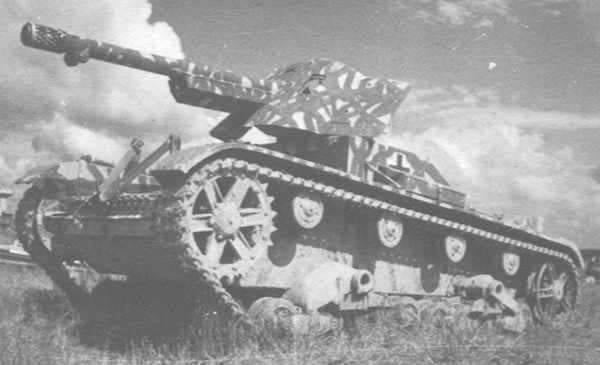
In addition to the Eastern Front, 75-mm guns fought in small numbers in Libya and Tunisia. They found application in the fortified positions of the Atlantic Wall. In addition to the Wehrmacht, 7,5cm Pak 97 / 38 were shipped to Romania as well as Finland.
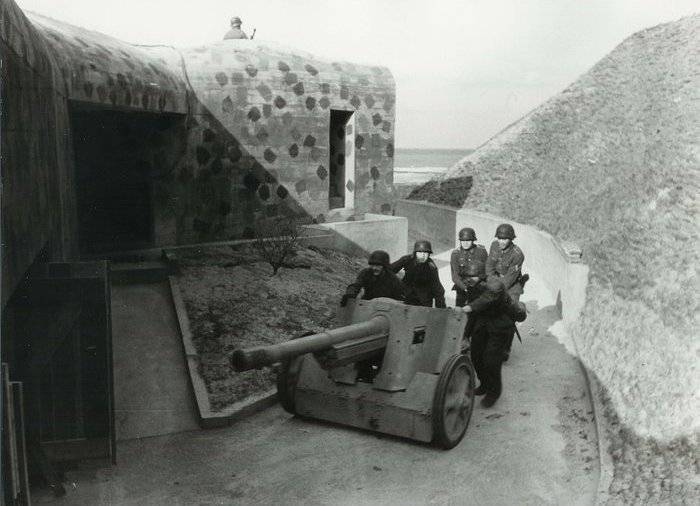
Although the 7,5cm Pak 97 / 38 were relatively few in relation to the number of 50-mm 5,0 cm Pak 38 and 75-mm 75-mm Pak 40 anti-tank guns delivered to the troops, they had a significant impact on the course of the battles until the second half of the 1942 year. Having received such guns, the infantry divisions could fight with heavy and medium tanks, for the destruction of which they had to previously use 88-mm anti-aircraft guns. Most of the 7,5cm Pak 97 / 38 available on the Eastern Front was lost at the beginning of the 1943 year. Already in the middle of the 1944 year, the 75-mm “hybrid” guns practically disappeared in the anti-tank divisions of the first line. In March 1945, a little more than 100 copies remained in service, suitable for practical use.
To be continued ...
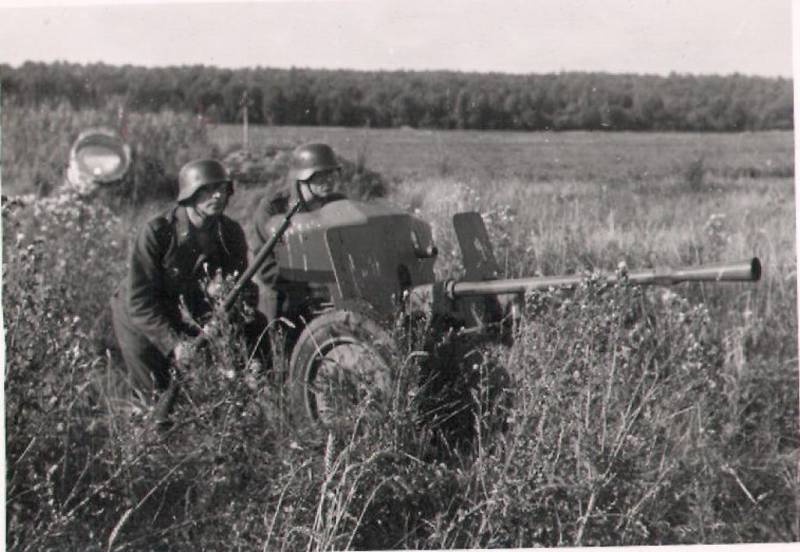
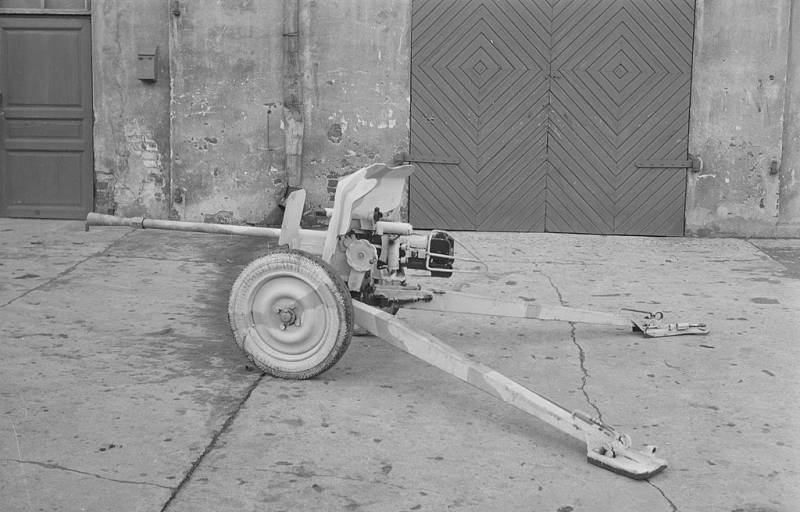
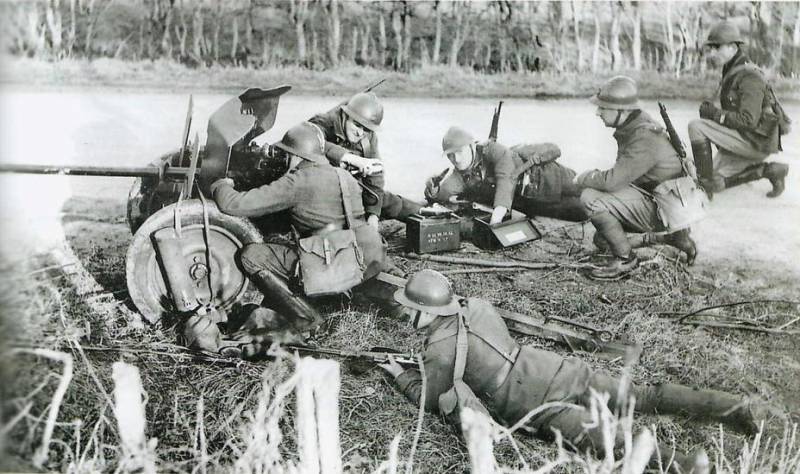
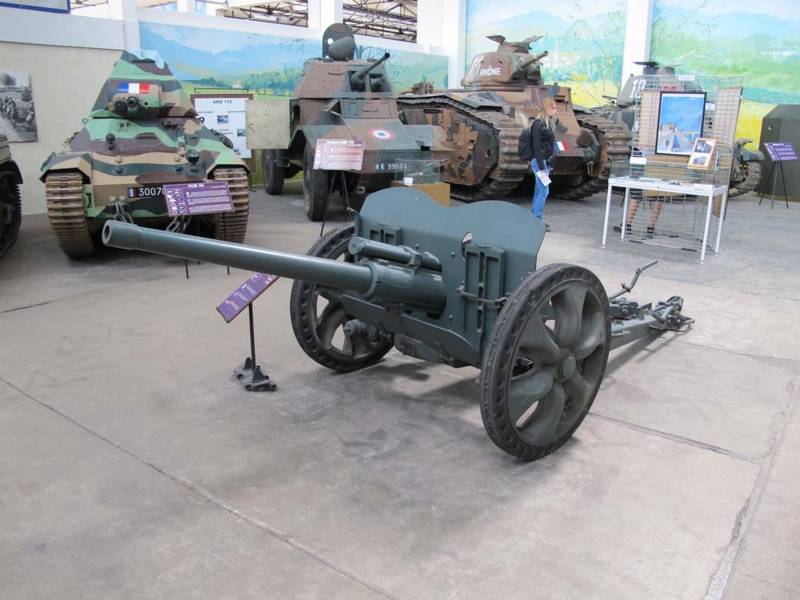
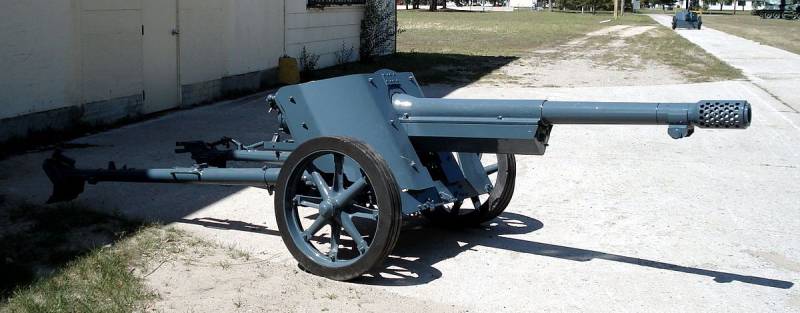
Information